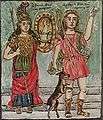Theophilos Hatzimihail

Theophilos Hatzimihail (Greek: Θεόφιλος Χατζημιχαήλ or Θεόφιλος Κεφαλάς; born c. 1870, Vareia, near Mytilene, island of Lesbos; died in Vareia, Greece, 24 March 1934), known simply as Theophilos, was a major folk painter of Neo-Hellenic art. The main subject of his works are Greek characters and the illustration of Greek traditional folklife and history.
Life and work
The exact birthdate of Theophilos is unknown. However, it is believed that he was born between 1867 and 1870 in Vareia (Βαρειά), a village outside of Mytilene (then part of the Ottoman Empire). His father, Gabriil Kefalas, was a shoemaker, while his mother Pinelopi Hatzimihail was a daughter of an iconographer. When he was very young he was mediocre at school, but he had a special interest in painting, having learned the basics from his grandfather.
His life was very hard in part because people made fun of him, since he went around wearing the traditional Greek kilt, the fustanella. At the age of 18 he abandoned his home and family and worked as a gate-keeper (καβάσης, kavasis) at the Greek consulate in Smyrna.
There he stayed a few years, before he settled in the city of Volos in about 1897, searching for occasional work and painting in houses and shops of the area. Many of his murals exist today. Most of his years he spent in Ano Volos. His protector during that period was the landholder Giannis Kontos, for whom he did many works. Today the house of Kontos is the Theophilos Museum. As well as painting, he was also involved in organizing popular theatrical acts for national ceremonies, and in the carnival period he had a major role, sometimes dressing as Alexander the Great, with pupils in macedonian phalanx formation, and sometimes as a hero of the Greek Revolution, with gear and costumes made by himself.
In 1927 he returned to Mytilene. Legend states that he left Volos because of an incident in a kafeneio (coffee shop), when someone played a joke on him in front of others and threw him down from a ladder where he was painting.
In Mytilene, despite the mockery of the people, he continued to draw, painting many murals in villages for little payment, usually for a plate of food and a cup of wine.[1] Many of his works of this period have been lost, either due to natural aging or from damage by the owners.
In Mytilene, the renowned art critic and publisher Stratis Eletheriadis (Tériade), who lived in Paris, discovered Theophilos and brought him a great deal of recognition and also international publicity, though posthumous. With Tériade's funding in 1964 the Museum of Theophilos was constructed in Vareia, Lesbos.
Theophilos died in March 1934, on the eve of the Annunciation, perhaps from food poisoning. One year later, his works were exhibited in the Louvre as a sample of a genuine folk painter of Greece.
In popular culture
- Theophilos Hatzimihail at cine.gr (Greek)
Gallery
 Erotokritos and Arethousa
Erotokritos and Arethousa Athena and Artemis
Athena and Artemis Symposium of Empress Eudoxia
Symposium of Empress Eudoxia Constantine Palaiologos
Constantine Palaiologos Alexander the Great
Alexander the Great Captain Androutsos, father of Odysseas Androutsos
Captain Androutsos, father of Odysseas Androutsos
References
- ↑ In the novella Vasilis Arvanitis, Stratis Myrivilis describes a coffee house near the Karini spring in Lesbos as famous because “its walls, inside and out, are covered with pictures and designs by the painter Theophilos.” Of Theophilos himself he writes: “He was a strange man and people thought him half crazy.” (Stratis Myrivilis, Vasilis Arvanitis, translated into English by Pavlos Andronikos [Armidale: University of New England Publishing Unit, 1983], pp. 51-2.)
Sources
- Yannis Tsarouchis, Theophilos (Athens: The Commercial Bank of Greece, 1966).
- Odysseas Elytis, The Painter Theophilos, pub. Ypsilon, Athens 1996. ISBN 960-17-0011-0.
- Kitsos Makris, The Painter Theophilos at Pilios, 3rd εdition, εκδ. Δημοτικού Κέντρου Ιστορικών Ερευνών, Αρχείων και Εκθεμάτων Βόλου, Volos 1998. ISBN 960-85703-1-X.
- Ε. Παπαζαχαρίου, Ο άλλος Θεόφιλος, εκδ. Κάκτος, Αθήνα 1997.
- Ντ. Παπασπύρου, Θεόφιλος Γ.Χ. Μιχαήλ, εκδ. Ιανός, Θεσσαλονίκη 1998. ISBN 960-7771-16-8.
External links
| Wikimedia Commons has media related to Theophilos Hatzimihail. |
- Theophilos Museum - House of Giannis Kontos (Volos)
- Museum of Works by Theophilos(Mytilene Lesbos Island Greece)
- Biography and works
- The death of Theophilos (Ιστορία Εικονογραφημένη, August 2002)
- Article in news paper Ta Nea, 3 January 2000
- Odysseas Elytis on Theophilos